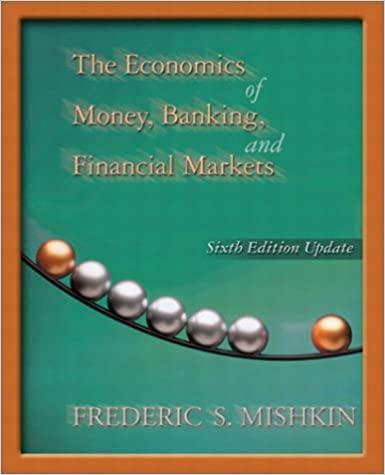Question
1. The yearly returns of a stock (in excess of the risk-free rate), are +1.8%, -0.6%, -0.3%. During that same period, the market portfolio has
1. The yearly returns of a stock (in excess of the risk-free rate), are +1.8%, -0.6%, -0.3%. During that same period, the market portfolio has excess returns of +0.7%, +0.4%, and +0.8%.
| Stock A excess ret. | Market excess ret. | |
| Year 1 | 1.80% | 0.70% |
| Year 2 | -0.60% | 0.40% |
| Year 3 | -0.30% | 0.80% |
In theory, what should be the stock's CAPM alpha with respect to the market?
2. Same data as previous question.
In practice, what is the stock's CAPM alpha with respect to the market?
3. Same data as previous question.
In practice, what is the stock's CAPM beta with respect to the market?
4. Under APT, what is the alpha of a diversified portfolio?
Group of answer choices
the market risk premium
0
the systematic risk
1
5. The yearly returns of Fund A (in excess of the risk-free rate), are 5.00%, 6.32%, -5.20%. The yearly returns of Fund B (in excess of the risk-free rate), are 0.00%, 1.32%, -10.20%.
During that same period, the market portfolio has excess returns of 5.00%, 7.20%, -12.00%.
| Fund A excess return | Fund B excess return | Market excess return | |
| Year 1 | 5.00% | 0.00% | 5.00% |
| Year 2 | 6.32% | 1.32% | 7.20% |
| Year 3 | -5.20% | -10.20% | -12.00% |
The risk-free rate is 3% per year.
What is Fund A's alpha?
6. Same data as Question 5.
What is Fund B's beta?
7. Same data as Question 5.
Based on your analysis, which fund has the most systematic risk?
Group of answer choices
Neither Fund A nor B
Fund B
We do not have enough information to tell
Fund A
8. Same data as Question 5.
If I can hold long positions only in these funds, and expect fund managers to keep performing the same way against the market, which of the following options should I pick?
Group of answer choices
Fund A only
Both Fund A and B in proportion of their market value
Fund B only
Half in Fund A, Half in Fund B
9. Same data as Question 5.
Now suppose you can go either long or short (without paying fees), and still expect fund managers to keep performing the same way against the market.
You think the market can either move +5% or -2% next year, but you do not know with what probability.
Which of these positions would give you the highest expected return?
Group of answer choices
Long Fund A and B in proportion of their market value
Long Fund B only
Long Fund B, short Fund A in the same proportion
Long Fund A, short Fund B in the same proportion
10. Assuming you follow your (correct) answer to question 9, what would be the market beta of your portfolio?
Please answer questions 1-10 with work shown if possible! thank you!!
Step by Step Solution
There are 3 Steps involved in it
Step: 1

Get Instant Access to Expert-Tailored Solutions
See step-by-step solutions with expert insights and AI powered tools for academic success
Step: 2

Step: 3

Ace Your Homework with AI
Get the answers you need in no time with our AI-driven, step-by-step assistance
Get Started


